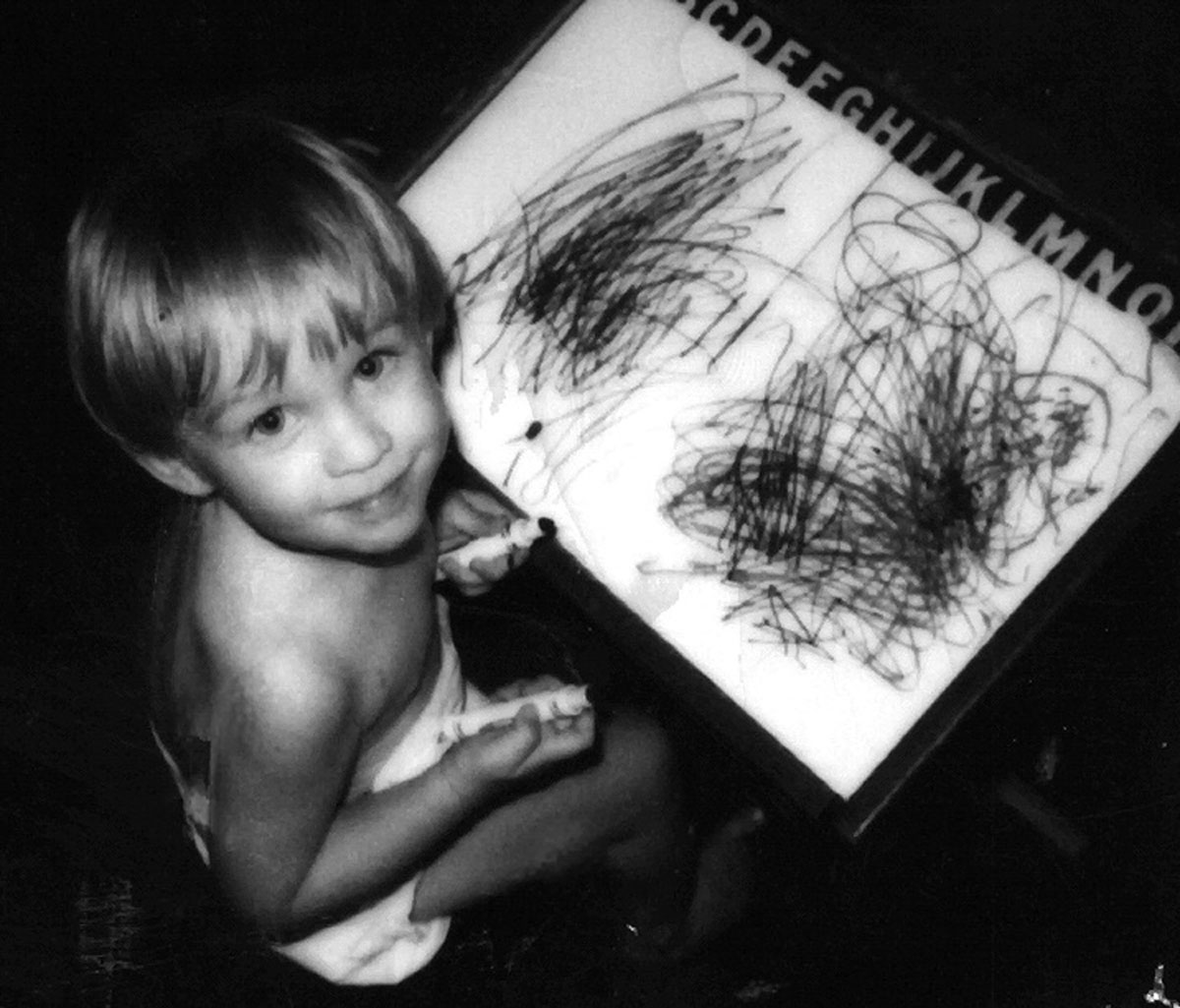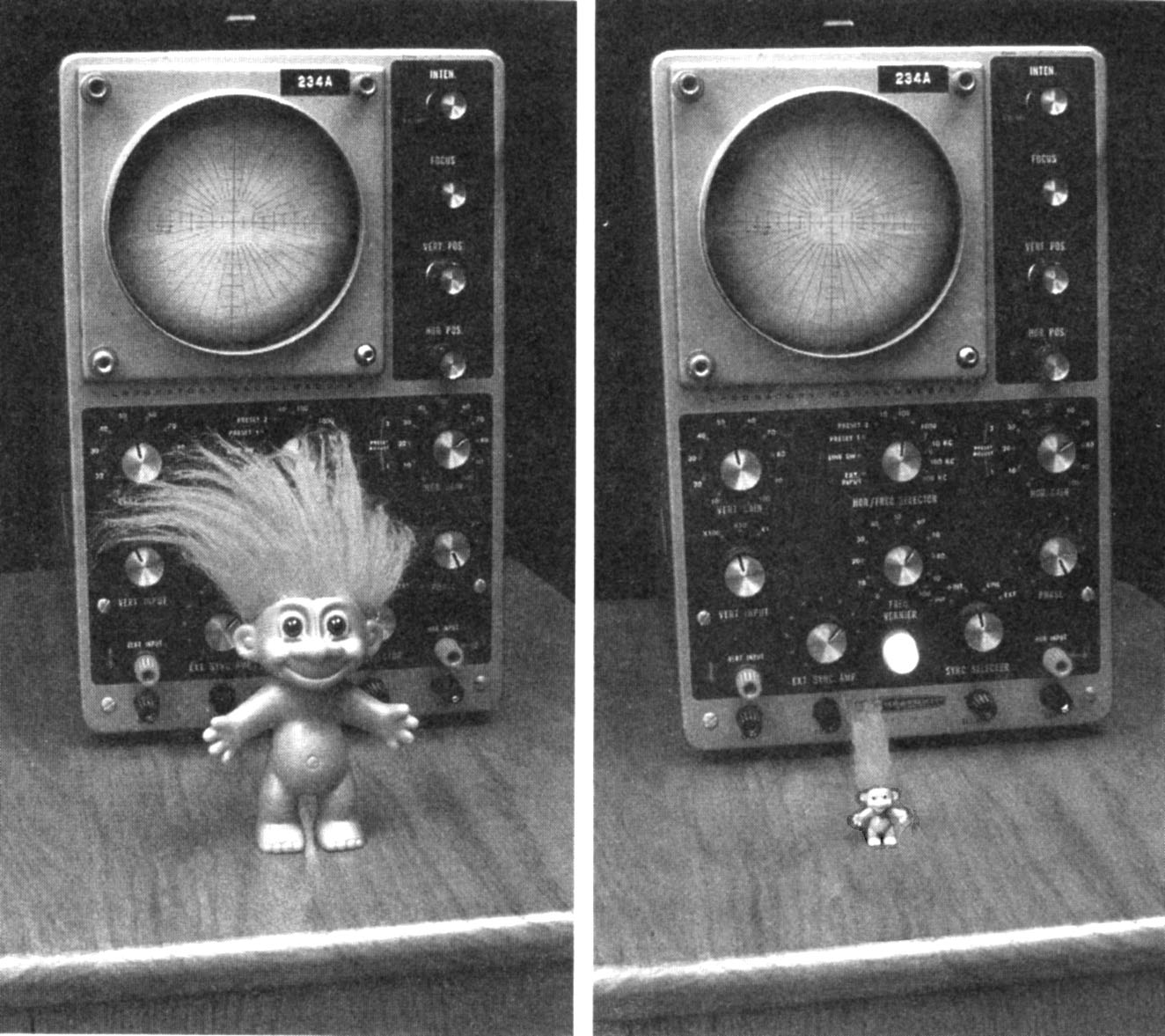Copyright © 2007-2018 Russ Dewey
Development of Higher Cognitive Abilities
Children only gradually come to understand symbols that relate to real-world objects. A symbol bears an abstract relationship to a real-world object or event. For example, maps are symbolic representations of environments. A 3-year-old typically cannot understand a map.
Competence with visual representations is slow to emerge. A typical 1.6 year old (like Johnny below) can recognize and point to objects in pictures, but cannot draw them and cannot relate to them as symbols (for example, treating a picture as a map of real world objects).

A typical 19 month old can point out objects in pictures...but cannot yet produce them.
In one ingenious experiment, DeLoache (1995) tested the ability of small children to understand map-like relationships. The experimental task involved toys hidden in a big room or a smaller model of the same room.
How did DeLoache investigate symbolic abilities of 3 year olds?
The experimenter showed where the toy was hidden in one room, and the child was supposed to find the corresponding toy in the other room. For example, a teddy bear might be hidden behind a couch pillow in the big room, then the child was supposed to find a tiny teddy bear hidden behind a miniature couch pillow in the model.
Three-year-old children (36-month olds) caught on to the game right away. They could find the little teddy bear in the model, if they saw the big one being hidden in the larger room.
However, 30-month-olds, just six months younger, usually did not catch on. They saw the toy being hidden in the big room, but when given access to a model identical to the big room, they explored randomly.
DeLoache hypothesized that 30-month-
Why did the 30-month-olds fail?
Next DeLoache tricked a group of 30-month-olds. She told them she had a shrinking machine that could shrink the big room down to a small one. To demonstrate the shrinking machine, she showed the children a large troll doll.

The incredible shrinking machine at work
It was placed near the shrinking machine, then the experimenter and the child went into another room where they listened to computer generated "sounds the shrinking machine makes when it's working."
They came back into the experimental room to find a tiny troll by the shrinking machine. The children were completely fooled. They believed the troll had shrunk. ("Remember, most of these children also believe in the tooth fairy," DeLoache pointed out.)
What happened when 30-month-olds thought the room had shrunk?
Now came the pivotal part of the experiment. DeLoache showed children a large tent-like room. Then they left the area while the shrinking machine operated.
When they returned, the big room was gone, and the little model of it was there instead. "The sight of the model in place of the room was very dramatic," reported DeLoache.
Now that the 30-month-olds thought it was the same room only smaller, they had no trouble finding a toy in the model, at the same place where it had been left in the big room. This clever demonstration showed that their problem, in the earlier task, was relating two different spaces (so one was a model or map of the other). When that problem was eliminated, they had no trouble with the task.
Nothing had changed except the way the children interpreted the situation. They thought they were dealing with one space, instead of two. But that was enough to overcome the difficulty they had earlier. It also pinpointed what they were lacking at 30 months: the ability to form an abstract relationship between two spaces.
How does this research continue the theme established by Piaget?
Although DeLoache never mentioned Piaget, this research continued the theme established by Piaget over 50 years earlier. Children do not arrive in the world with all the mental skills and abilities they need to interpret events; they develop those capabilities gradually.
Piaget showed that very young children could not represent abstractions like liquid quantity or mass. DeLoache showed they did not understand map-like relationships. Children gain such representational abilities as they develop, and experiments can show when each cognitive skill appears.
Can mature chimpanzees perform this task?
Mature chimpanzees evidently do have the ability to form an abstract relationship between two spaces, as defined by this task. Their behavior is like that of older humans.
Sarah Boysen, whose ingenious work with chimps was mentioned in Chapter 8, demonstrated this on the television program Scientific American Frontiers. Dr. Boysen hid a miniature soda can in a doll house, and the chimpanzee immediately retrieved it from the corresponding place in the larger room. Unlike 30-month-old humans, adult chimpanzees had the ability to use one space to map another.
Metacognition in Childhood
Flavell called the child's awareness of the distinction between appearance and reality an example of metacognition. That is a concept we encountered in Chapter 6 (Memory) and Chapter 7 (Cognition).
Metacognition is awareness of our own mental processes. When a child learns that appearances can be deceiving, the child is showing awareness that mental representations can be inaccurate, which is crucial knowledge about the thought process.
What is metacognition?
Young children can be remarkably ignorant of basic mental processes. In one study, Flavell and two other researchers simply asked 5-year-olds whether they ever forgot anything. Thirty percent said they did not!
How did Flavell demonstrate deficiencies in metacognition with one simple question?
Even when they are taught to use information processing strategies, children do not always use their new skills without prompting from adults. A classic example comes from research on memory in children.
Adults who try to remember something will often rehearse the information, saying it over and over in their heads. This helps maintain information in working memory, so it can be retained, for example, while dialing a phone.
What did Kingsley and Hagen discover when they taught children how to rehearse word lists?
Rehearsal is simple for adults, but it does not come naturally to little children. Kingsley and Hagen (1969) taught nursery school children to rehearse words in a list. It improved their retention.
However, after successfully using the technique, the children seldom rehearsed on their own. They had to be reminded to do it until they were 7 years old or older. The older children remembered to do it on their own.
Similar results were reported by Paris, Newman, and McVey (1982). They taught children to sort objects into different categories before trying to memorize them. This greatly improved the children's memories.
But when the children were tested again on a very similar task, they failed to use the strategy on their own. This illustrates a basic difficulty with teaching metacognitive skills. Children can learn complex mental tools, but they may not remember to use them when appropriate. That is a meta-cognitive skill in itself: remembering to use mental strategies.
---------------------
References:
DeLoache, J. S. (2016) Early understanding and use of symbols: The model model. Current Directions in Psychological Science, 4, 109-113. doi:10.1111/
Kingsley, P. R. & Hagen, J. W. (1969) Induced versus spontaneous rehearsal in short-term memory in nursery school children. Developmental Psychology, 1, 40-46. https://dx.doi.org/
Paris, S., Newman, R., & McVey, K. (1982). Learning the functional significance of mnemonic actions. Journal Of Experimental Child Psychology, 34, 490-509.
Write to Dr. Dewey at psywww@gmail.com.
Don't see what you need? Psych Web has over 1,000 pages, so it may be elsewhere on the site. Do a site-specific Google search using the box below.
